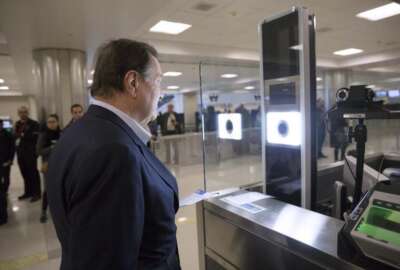
DHS S&T concludes facial recognition can work for small groups, while maintaining privacy
The results from the “2022 Biometric Technology Rally” could inform the way forward for TSA and other government agencies as they increasingly adopt facial ...
Department of Homeland Security scientists think certain facial recognition systems can efficiently verify the identities of small groups of travelers while preserving the privacy of those who opt-out, as the Transportation Security Administration considers how technology could speed up security lines at airports.
The results from the DHS Science and Technology Directorate’s “2022 Biometric Technology Rally” unveiled this week could inform the way forward for TSA and other government agencies as they increasingly adopt facial recognition systems, despite concerns from some lawmakers and civil liberties groups.
“The intention is to put out objective, hopefully clear information to people so that they can make better decisions in the acquisition process,” Arun Vemury, DHS S&T Biometric and Identity Technology Center lead, said during a Feb. 23 press conference.
The 11 days of testing at the Maryland Test Facility in Upper Marlboro, Maryland, evaluated 40 facial recognition configurations in an airport-like environment. The tests included four “face acquisition systems” and 10 face-matching algorithms. DHS S&T declined to identify the companies involved the tests, citing an agreement to keep the results anonymous.
The best combination of acquisition system and algorithm could identify 97% of people in groups of two or four, in less than two seconds per individual, according to the directorate. The rally set the threshold goal of correctly identifying at least 95% of users in groups of both two and four in less than three seconds per individual.
“We were able [to] basically show that the assumption that we have to process people one at a time, may not really hold, that we can at least go up to groups of two and four without losing any efficiency and without really seeing a major drop in matching performance,” Vemury said.
Yevgeniy Sirotin, the principal investigator for the 2022 rally, said the tests showed promise for a variety of use cases, pointing to screening at land, sea and airports.
“We think some of these technologies that were showcased as part of this rally might be applicable there,” Sirotin said.
The tests also challenged vendors to only capture the faces of participants who “opted-in” to the face-matching system, while avoiding bystanders. It was the first year a biometrics rally had included a privacy component since DHS S&T started hosting the events in 2018.
Vemury said facial recognition cameras have often been configured to collect as many faces as possible in the field of view. But during the rally, the tested systems largely met the privacy requirements by only capturing individuals standing in areas designated for biometric processing.
“I think from the privacy side, we’ve seen that if you specify it, industry can come up with solutions to help address or minimize that problem,” Vemury said.
The DHS S&T tests also found cameras and image quality were the main sources of error in face-matching for certain demographics, rather than the algorithms themselves. Some camera systems struggled more than others to capture quality images of darker skin tones, as well as very light skin tones.
Other government agencies, including the General Services Administration and the National Institute of Standards and Technology, has found disparities in performance across commercial facial recognition systems and some algorithms for certain demographic groups, including African Americans.
“Fundamentally, this is a physics problem,” Sirotin said. “These cameras can sometimes not be configured properly to take good images, regardless of skin tone, and in some cases, that results in overexposure. In some cases that results in under exposure. And this result shows that the cameras do need to be configured to make sure that they take quality pictures of everyone.”
TSA already using face recognition
The results from the 2022 rally come as TSA considers how technologies, including biometrics, can be used to speed up security screening at airports. Customs and Border Protection is also using facial recognition at ports of entry.
Dan Daly, deputy director of the Information Assurance and Cybersecurity Division at TSA, said a major focus is how technologies can address staffing challenges with transportation security officers at airports.
“How we can really enable their activities through technology, I think is a primary mission space for our administrator at the moment,” Daly said at the Feb. 22 Digital Transformation Summit hosted by ACT-IAC and Meritalk. “There’s a lot of effort underway to really look at how we can create some efficiencies in what we’re doing at the checkpoint so that you don’t have to see 100 TSOs standing there, and maybe we can reduce that number down by a factor of 20%, 30%, 40%.”
A 2022 report from the Homeland Security Advisory Council’s “customer experience” subcommittee specifically recommended DHS continue exploring the use of digital technologies and biometrics. The subcommittee included several private sector executives, including from two from major airlines.
“Biometrics, such as facial matching technology, allow for a greater level of certainty about identity and enhance the customer experience for those customers that want an efficient and touchless experience,” the report states. “DHS should identify if it can further innovate its use of opt-in biometrics to reduce officer interactions for those passengers whose identities have been verified and are otherwise determined to be low risk.”
TSA is already piloting facial recognition for individual processing in 16 major airports. But several lawmakers recently called on TSA to halt its use of facial recognition at airports, citing privacy and civil liberties concerns. They also say TSA has not put in place good “opt out” procedures for travelers who don’t want to use facial recognition. Lawmakers also raised questions about how TSA stores and protects biometric data.
Vemury said the 2022 technology rally shows facial recognition systems can be configured to meet certain parameters, but should be applied carefully.
“There are technologies that will work well and work equitably and hit that 95% performance threshold,” he said. “However, we also see some technologies that fall below that for some demographic groups. So while there are available solutions that can do that today, we can’t just take it at face value that all technologies are available today. This kind of highlights the importance of testing and evaluating for specific use cases with diverse volunteers to make sure that we actually are picking the right technologies for specific applications.”
The Biometric and Identity Technology Center is now preparing to launch a Remote Identity Validation Technology Demonstration to determine whether there are systems that can accurately evaluate the validity of identity documents submitted by a phone or other remote system. The tests hold implications for agencies looking to combat fraud in public benefits and services.
Copyright © 2024 Federal News Network. All rights reserved. This website is not intended for users located within the European Economic Area.
Follow @jdoubledayWFED
Related Stories

Biden administration trying to find happy medium when it comes to facial recognition




